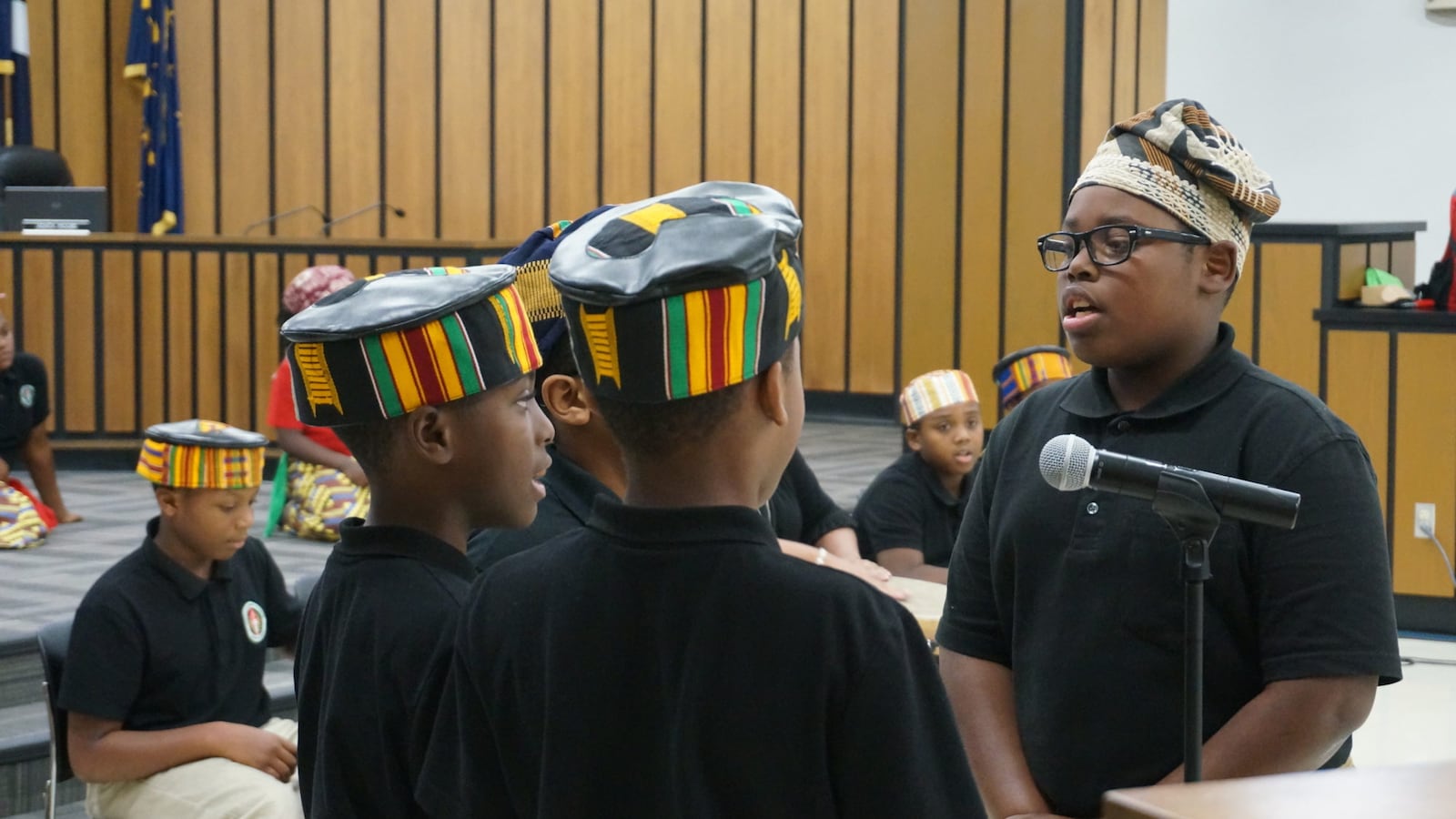When Deonah Doyle first heard the elementary school her two children attend could be overhauled with a new principal and new teachers, she was afraid.
A neighborhood school northwest of downtown Indianapolis, School 42 has been through a lot over the years — a lot of principals, a lot of teachers, and a lot of turmoil, she said. It was also plagued by years of low test scores, leading to the threat of state intervention.
But the overhaul would likely remove most of the educators Doyle and other parents knew and trusted. “It was very scary for the kids and for me,” she said.
When the school board voted in March 2017 to restart her school, Doyle became one of hundreds of parents caught up in a movement that’s redefining Indianapolis Public Schools. Last summer, School 42 became an innovation school, a new model that allows outside operators to run district campuses.
Over the last three years, the innovation network has grown to 20 schools, including new and existing schools that chose to join. School 42 is one of six struggling campuses that have been restarted as innovation schools in an aggressive attempt to improve test scores and stave off state intervention. This year, innovation schools are expected to enroll 6,000 students — close to 20 percent of the district.
Innovation schools, like many facets of school choice, are politically contentious, with advocates and skeptics sparring over how they could ultimately reshape the district. Three years in, there are some data points that show test score improvements and growing enrollment at some innovation schools. But most of the changes that the transformation has wrought are not as easy to capture on spreadsheets.
It’s people inside schools — parents, teachers, and community members — who have a close-up perspective on how innovation is changing them. At School 42, they talk about the added extracurricular activities, the new approach to discipline, and the increased community engagement. They also talk about the teachers who left and the steep challenges the school still faces.
Although Doyle was initially wary of the restart, she changed her mind once she came to trust the new co-principals who led the overhaul of School 42. “When I talked to them, I could really tell that they were truly here for our babies. They were truly here for the community,” she said. At a meeting at Starbucks, the principals gave her their cell phone numbers, and they asked what they could do to help her, she added. “That sold me.”
*****
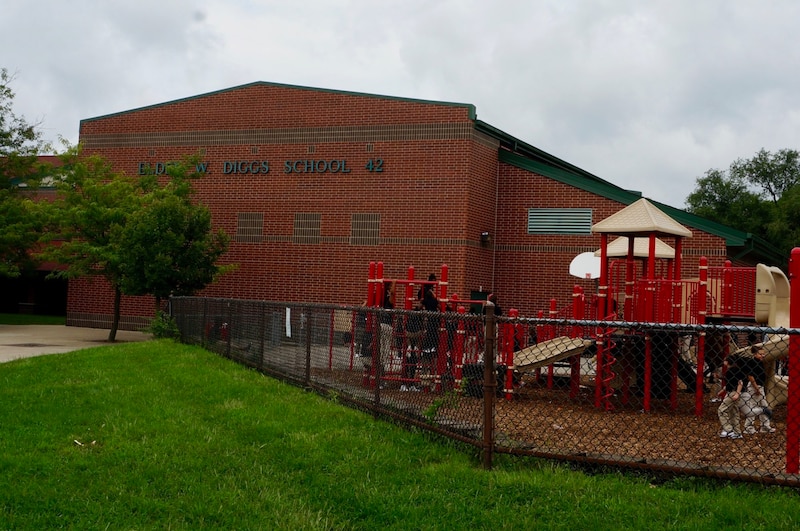
School 42 has an unremarkable campus: a boxy red brick building sits in a neighborhood with tree-lined streets and small houses and duplexes. The vast majority of the school’s students are black, and nearly all of them come from low-income families. The school was named Elder W. Diggs after a principal there who was also the first black graduate from the Indiana University School of Education. When it was taken over in the summer of 2017, the school was renamed Ignite Achievement Academy at Elder W. Diggs School.
There was a time when School 42 had a good reputation, and students typically went on to Crispus Attucks, the city’s storied black high school, said Reginald Jones, who led the nearby Watkins Community Center in the 1980s.
“It was kind of a different neighborhood,” he said. “The parents knew each other. The children knew each other. It was a poor neighborhood, but it was not a violent neighborhood.”
Over the years the community changed, and there is now persistent violence, said Jones, who volunteers at Ignite. He counsels a group of boys with behavior problems, and last year, many of those students told him they had family members killed in the community, he said. “Some saw it happen,” he added. “When you’re dealing with traumatic experiences like that, you can see how it loses the importance of education.”
In recent years, the school has had a rocky path academically. Its passing rates on state tests have been consistently low, and the school received years of failing grades from the state. A principal who took over in 2015 was making improvements at the school, parents and teachers said. Its state letter grade rose to a D.
When district officials were considering whether to restart the campus as an innovation school, that principal resigned. Instead of hiring a replacement to lead the school, the school board decided to hand over management to Ignite, a new charter school founded by Shy-Quon Ely II and Brooke Beavers.
It was a controversial decision. When the school was restarted, teachers who wanted to stay had to apply to work for Ignite — and the vast majority ultimately left the school.
More broadly, opponents of innovation schools raise a host of concerns. Most teachers at innovation schools don’t work directly for the district, so they are not part of the Indianapolis Public Schools teachers union. Skeptics say the schools do not have enough oversight and the district is ceding schools to outside operators that are not controlled by voters or parents.
Ignite started last school year with about 500 students. A combination of good word-of-mouth and families moving meant that by the end of the year, enrollment reached about 560 children, a significant bump from before the takeover, according to Ely. Most students come from the surrounding neighborhood, but Ignite is also open to students outside the school boundary.
Beavers and Ely previously co-led a school across town in the Tindley charter network. When they took over School 42, they hired nearly all new teachers and school staff, extended the school day, and rolled out new approaches for dealing with students who have discipline problems. They also began a sustained effort to get families and community members involved with the school.
Their ultimate vision is one of reciprocity, where the community invests in the children and they, in turn, have a positive impact on the neighborhood around them. That started with recruiting community partners like Ivan Douglas Hicks, the pastor at a church about a half mile away from the school. First Baptist Church has been involved with School 42 for decades — the school’s first graduation took place at the church, Hicks said. Over the years, congregants have mentored and tutored students, he said. But the relationship has waxed and waned, said Hicks, who has led the congregation for nearly 20 years.
When Ely and Beavers took over, the ties between the church and the school grew tighter. Hicks has a doctorate in African American Studies from Temple University, and he once attempted to start a charter school. When Hicks learned Ignite would use an Afrocentric curriculum, he offered to help get the school off the ground.
Now, Hicks leads the Ubuntu Council, a group that brings together Ignite parents, teachers, and community members that he described as a parent-teacher organization “on steroids.” Ubuntu means “I am because we are,” and the group aims to surround parents and teachers at the school with a wider community, Hicks said. Last year it attracted about 45 people, Hicks estimates. “There’s been a very intentional effort to reach out to, not just neighborhood, but wider community organizations,” Hicks said. “It’s the culture.”
*****
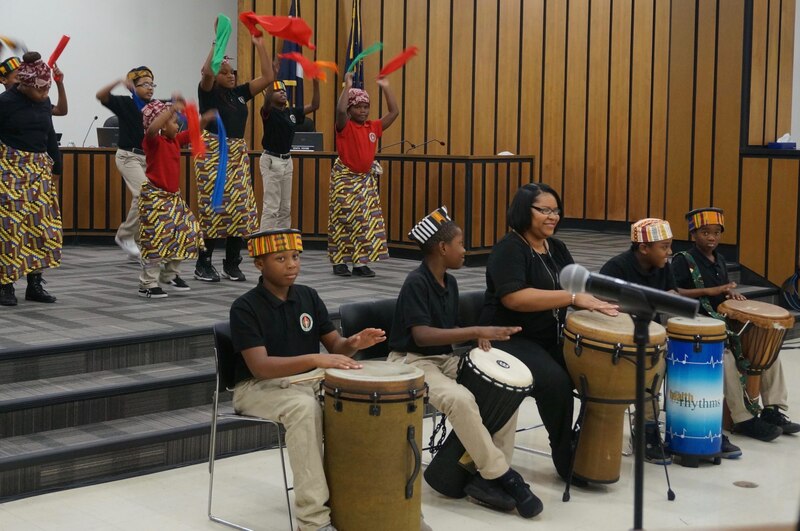
Even though Ignite has existed for just one year, the school has already created enough enthusiasm for parent events that routinely attract crowds — a sharp contrast with many neighborhood schools. On a Wednesday in April, close to 100 parents and students jammed around tables for a learning party. They discussed why raisins bounce in Sprite and what happens when dish soap is added to pepper and water.
On a mic that worked only intermittently, co-principal Beavers led the students through the scientific method. “After you do your experiment, you’re going to draw a conclusion. What do you think that means?” she asked. “Turn and talk to your parent. What do you think ‘make a conclusion’ means?”
The joy of science isn’t the only enticement that brought such a big crowd: Occasionally, Beavers stopped to read off winning raffle numbers. By the door, a table was piled high with boxes of pizza.
Before Ignite, meetings or events at School 42 attracted just a handful of people, parents and staff say. Now they are filling the gym. “It’s changed a lot,” said Philica Baker, a mother at the science party. “There’s a lot more parents involved.”
The learning night was one of more than a dozen events Ignite has hosted, Ely estimates. There was a peace march. A homecoming dance. A spring celebration. A literacy fiesta. And a back-to-school block party.
Those events take a lot of work, but they are an essential piece of the growing community, Ely said. They build trust between the school and families, and they give parents and children a chance to create positive memories around education.
“We wanted to make sure that we had a lot of opportunities for parents to be involved, for them to come in and see their children,” he said. “We are inviting you in.”
*****
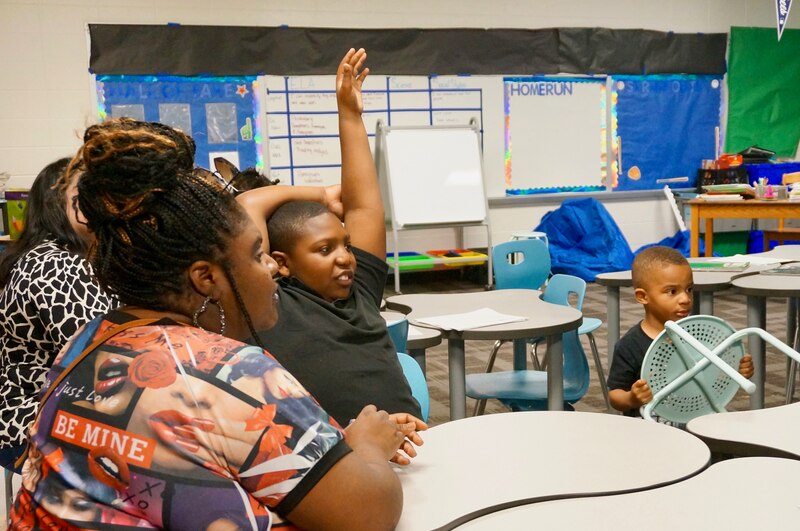
When it comes to seeing how innovation is changing School 42, parents have on-the-ground insight, and their perspectives are often shaped by the details that define their children’s experience. For Shawanda Tyson, whose son is a fourth-grader, one of the most significant changes at Ignite over the last year is the focus on trying to keep kids in school by reducing suspensions and teaching them to control their emotions.
When Tyson visits School 42, it’s obvious she is a fixture. As she walked the halls on a Thursday afternoon in May, she talked with students, and a passing staff member asked if Tyson made it to her shift at Walmart that day. She skipped her shift to come help her son with school, Tyson said, but “it’s OK.”
The main reason that Tyson spends so much time at School 42, including several hours that Thursday, is because her 10-year-old son has autism. School can get overwhelming, and he often gets in trouble, she said. Sometimes he struggles to focus. Other times, he throws chairs or turns over desks. When he was 8 years old, he walked out of the building and headed down the street. “He would just take off running,” Tyson said.
“What I feared the most with my child having the autistic abilities that he had was that they would give up on him because he sometimes can be a hard case,” she added.
Like many other parents at School 42, Tyson liked the last principal, and she thought the school was improving. Some things about the restart were hard on her son, like losing his beloved special education teacher. But, ultimately, Tyson supported the restart. She is in the parent organizing group Stand for Children, which often supports innovation schools, and she trusted Beavers and Ely.
Over the last year, Tyson said, her son still struggled. He was in a traditional class, and Tyson loved his teacher. But she had taken on many of the more challenging students, and they could be distracting, Tyson said. He had to go to summer school because he didn’t pass the state reading test. This year, he is in a class for students with special needs, she said.
For all the challenges her son faced, Ignite has improved the school in many ways, Tyson said. For much of the year, her son was happier, and he took extracurricular classes he liked. He also spent far less time out of school. The year before Ignite took over, Tyson was routinely asked to pick him up from school because he was having problems, and he was suspended several times, Tyson said. In Ignite’s first year, her son was suspended twice, and he was sent home a handful of times, she said.
Many bad days he was able to stay in school, Tyson said. Instead of asking her to pick him up, Ignite staff asked her to talk with him. They call and say, he is “having a bad moment,” Tyson said. They take him to the resource room, where he has activities to calm himself down, or they ask Tyson to come in and help get him back on track so he can stay in school. “They have not ever given up on him,” she added.
*****
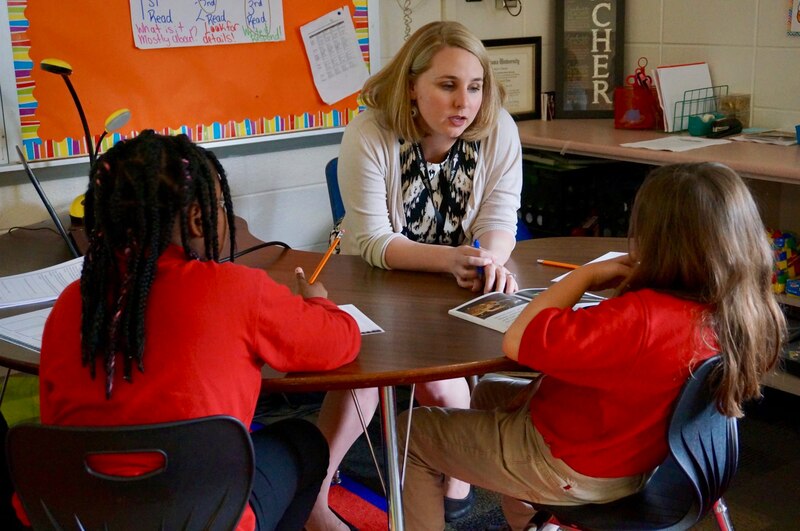
Parents are often the best witnesses to what changes when a campus is restarted as an innovation school because the vast majority of the staff and teachers typically leave. At School 42, one exception is Janelle Nolan, a teacher who was at the school before and after Ignite took over.
When the school restarted, the existing teachers were displaced, and if they wanted to stay, they had to apply for jobs with Ignite. Because the teachers work for the charter school, they cannot join the district union, and there might be financial costs to switching jobs. Nolan is one of two teachers who remained.
On a quiet spring morning, allergies and end-of-school lethargy had gotten so bad that about half of Nolan’s class was out. But her talent for keeping second-graders on track was clear, as she switched casually between her comments on student behavior — “That’s not kind, sir.” — and the academic topic at hand.
Students clustered in small groups playing a game where they compared pie pieces to see who had the largest fraction. Nolan asked a student to imagine the pieces were a pizza. Then, a boy left the others playing on the carpet and headed to the other side of the classroom. “He don’t want to play anymore. He’s mad,” said another boy. “He’s going to go to the cool-down corner,” replied Nolan. At a desk in the corner, the boy who was upset rested his head on his arms.
Nolan studied education at Indiana University-Purdue University Indianapolis, and she got a job at School 42 three years ago under the last principal. It was the only school where she had ever taught, and when the district decided to restart the school, she couldn’t bring herself to leave her students.
She says there have been dramatic changes since Ignite took over. Students at School 42 face lots of turmoil at home. There are children in foster care. Children with parents who are in jail. And children who have seen their parents shot, Nolan said. Ignite leaders have put a new focus on student mental health and discipline, she said.
Instead of having a single person who deals with behavior issues, they have a team, Nolan said. When students are frustrated, they have a cool-down corner in the classroom, as her student used, or they can go to another buddy classroom. There are two classrooms dedicated to students who are having behavior problems in class. And there are counseling services for students.
Ignite’s approach isn’t unique, Nolan said. Indianapolis Public Schools is trying those strategies at traditional schools. But at Ignite, she believes more staff members are dedicated to those issues. And because new staffers came on with the restart, they are on the same page about the right approach, she said.
Nolan left the school when she moved across the state. But after observing the change, she thinks the switch to innovation was the right move. “It’s not a one-size-fits-all thing,” she said. “It just depends on the building. And I really believe this has been good for the kids.”
*****
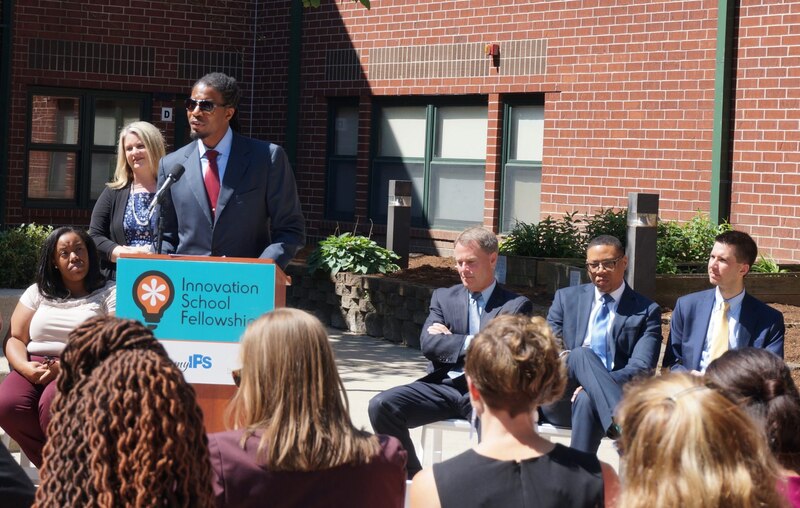
Three years into Indianapolis Public Schools’ innovation experiment, it can be difficult to draw broad conclusions. The schools are diverse by design, with different management structures, challenges, and educational philosophies.
“Innovation tells you they have some flexibility to do some things differently, but outside of that it’s very difficult to characterize them all in the same bucket,” said Indianapolis Public Schools Deputy Superintendent Aleesia Johnson. “There are lots of different schools who happen to be innovation schools.”
Officials often turn to data, such as test scores or rising enrollment, when measuring success. At the individual school level, the district looks at those measures to see whether innovation schools are making progress, Johnson said. While innovation schools run independently in most ways, the district still gets credit, and blame, for their students’ standardized test scores. Data on innovation schools is slowly accumulating, and some have seen boosts in their scores or rising enrollment.
State test results have not yet been released for 2017-18, the first year Ignite ran the school. The improvement on the school’s internal tests fell slightly short of its goals. This year, Ely said, the school will make some academic changes, including hiring three new instructional coaches.
The outstanding question is whether the cultural changes parents notice — new extracurricular activities, changes to discipline, more parent involvement — will eventually be paired with academic results. From Ely’s perspective, those changes are definitely laying the groundwork.
“Culture has to come first,” Ely said. “If we can see evidence that the culture is changing, then we can be patient and we can be content knowing that the academic piece is coming.”
Doyle, the mother who once opposed the restart, said that she is already seeing academic benefits for her daughter. Sitting on the gym bleachers last spring, she described how the school had helped her 8-year-old daughter during the first year. In the past, her daughter struggled academically but flew under the radar because she didn’t have discipline problems.
“She would tell me, ‘mommy, I’m slow,’ because kids would tell her [that]. I’m like, ‘no, you’re not,’ ” Doyle said. When Ignite took over, the second-grader started going to Saturday school and tutoring with New Era Church. Soon, she caught up to grade level for reading.
Despite the progress parents, teachers, and community members have seen, there is uncertainty in Ignite’s future. This year, the school will have small changes, such as shorter school days without as much time for extracurriculars. But it will also have a seismic shift: co-principal Beavers left the school at the end of last school year. Ely is now a solo principal.
Beavers, who is now principal of the Tindley middle school, said she left Ignite because running a charter school that is not part of a network entails significant administrative responsibility and she wanted to focus on her passion, instructional leadership. “I’m so proud to have launched the school,” she said.
Her departure is a source of anxiety for some parents, including Doyle, who said Beavers went above and beyond for the kids. It’s another moment of instability for the school. But Doyle now works at the school in the front office and doing parent engagement. She believes the team is resilient enough to cope with Beavers’ departure.
“I’m not saying that everything here is perfect, but it’s better than what it was,” she said three days into Ignite’s second year. “It ended up being a great opportunity for this community.”

